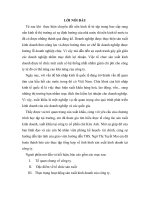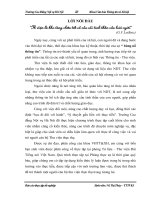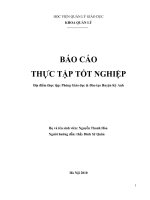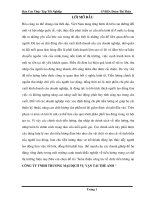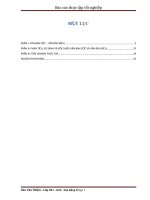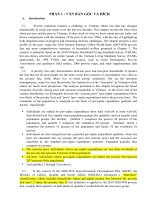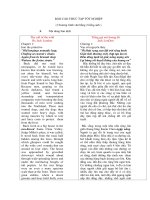Báo cáo thực tập tốt nghiệp tiếng anh (32)
Bạn đang xem bản rút gọn của tài liệu. Xem và tải ngay bản đầy đủ của tài liệu tại đây (199.42 KB, 44 trang )
PART A: INTRODUCTION
1. Justification of the study
In the integrating life, people from all over the world want to learn or
study a common language that is English. Thus it becomes international
language, used in many sectors, fields. Many countries in the world use English
as an official language and in many important fields such as: sport, medical,
music, aviation, business, commerce, etc. That is reason why all people from the
old to the young learn and study English. However, while learning, it is very
difficult to understand and use them such as: synonyms, hyponyms, especially,
antonyms.
Almost words have their antonym and they have different usages in many
ways: in the neutral way, in the way with respect and in the way with dislike. So
learning them we can understand more and more them.
However, to know or to identify all kinds of antonyms and the way of
using them is very difficult for the students and learners of English.
And may be the author will be a teacher of English in the future, so it is
very important and necessary for me to understand the difficulties facing
learners when learning antonyms. And contrasting antonyms between English
and Vietnamese will help students to learn vocabulary more easily.
Besides, the author also finds the issue quite interesting. Thereby, I
decided to choose this topic for my graduation thesis.
In the hope that, the study will help them avoid making mistakes when
using antonyms.
2. Aims of the study.
- Giving the general description, features and classification of English as
well as Vietnamese.
- Making a contrast between them to find out the similarities of antonyms
and differences in two languages.
1
- Researching antonyms used in communication, poetry, newspaper, prose
and funny stories.
-Helping the learners understand deeply about the usages of antonyms.
3. Methods of the study
- Descriptive method
- Analytic and synthetic method
- Comparative and contrastive method
4. Scope of the study
In the study, the author only mentions antonyms denoting existence and
non-existence in some contexts: daily communication, newspapers, prose,
poetry, and funny stories.
5. Format of the study
The study includes three parts:
Part A: Introduction
This part discusses the justification of the study, aim of the study, scope,
methods and format of the study.
Part B: Investigation
This part is divided in to four chapters.
Chapter 1: Theoretical background
Chapter 2: Antonym pairs denoting existence and non-existence in
English and in Vietnamese.
Chapter 3: Contrast analysis between antonym pairs denoting existence
and non-existence in English and in Vietnamese.
Part C: Conclusion
This part reviews major findings of the study and suggests some
directions for the further studies.
2
PART B: INVESTIGATION
CHAPTER I: THEORETICAL BACKGROUND
1.1. WHAT’S C.A?
1.1.1. Definition.
Understanding contrastive analysis is not easy. This is abstract large field.
From now on, there have been lots of definitions; however, I only mention the
definition proposed by Carl James, a famous linguist.
“Contrastive analysis is a branch of language comparative linguistics. It
compares and analyses the same order factor, features of the same objects based
on the linguistics documents”.
(1980:2)
Ex: - Everything disappeared in front of my eyes.
Mọi thứ đã biến mất trước mắt tôi
1.1.2. Types of C.A.
There are two types of C.A that are interior and exterior
Interior is comparison on the different units, categories of different levels
or aspects of only one language.
For example: when studying Vietnamese, we can compare antonym with
synonym about definition and type.
Exterior is comparison on the different units, categories, levels or aspects
of two or more languages.
For example: learning English we will study better if we know compare it
with our mother tongue about sentence structure, anonym and homonym, etc.
1.2. The word
1.2.1. Definition.
3
It is not easy to definite what the word is? The definition of word is one of
the most difficult in linguistics because the simplest word has many different
aspects.
Up to now, there have been many definitions about the word, some
linguists refer to phonology.
According to Arnold, I.V, “the important point to remember about
definitions is that they should indicate the most essential characteristic, features
by which this is distinguished from other similar notions”.
It is very important to show the most necessary characteristic, features by
distinguishing it from other similar notions.
For examples, in defining the word, one must distinguish it from other
linguistic units such as the morphemes or the word- group
Ex: when studying word:”natural”, we must know how many morphemes,
what root is, etc.
The word is a sort of focus for the problem of phonology, lexicology,
syntax, morphology and also for some other sciences that have to deal with
language and speech such as philosophy and psychology and probably quite a
few other branches of knowledge.
Although there are so many different definitions of word. It can be
understood as the smallest independent unit, which has meaning and can stand
alone.
Example: “happy” and “happily” are words but “ly” is not word
“Appear” and “disappear” are words but “dis” is not word.
From above definitions, we can summarize that: “The word is the
fundamental unit of language. It is dialectical unity of form and content. Its
content or meaning are not identical to notion but may reflect human notions
and in this sense may be considered as the form of existence.”
(The English word: Arnold, I.V, 1986:31)
4
1.2.2. Lexical meaning of word.
It is common knowledge that the word of a language is traditionally
classified into full and empty word.
There exists a close relationship between thee grammar and the lexicon a word,
part of the meaning is encoded in the grammatical structure of language.
Ex:
live and lived
Being forms of one and the same word, they share a lexical meaning but
differ in grammatical meaning. One is present, the other is past.
The definition of lexical meaning has been attempted more than once in
accordance with the main principles of different linguistics schools.
The disciples of F.de.Saussure consider meaning to be the relation
between the object or notion named and the name itself. Meanwhile
Bloomfielddian trend define the meaning as the situation in which the word is
uttered.
There are many ways of defining lexical meaning, each way has
individual characteristic, and however, seemingly all linguists agree that:
“lexical meaning is the realization of concept or emotion by means of definite
language system”.
1.2.3. The components of lexical meaning.
We may distinguish between two kinds of lexical meaning: denotation and
connotation.
1.2.3.1. The denotative meaning.
Denotation is the ability of a word or expression to identify all the objects
covered by the word.
That means these objects which are diverse in reality sharing certain
features relevant enough to be identical as covered by a word.
5
Ex: “computer” is used to denote a wide range of computing machine in
different shapes and sizes.
The denotative meaning may be significative, if the referent is concept or
demonstrative, if it is individual object.
Ex: “a good laugh is sunshine in the house”.
(The English word, 1986)
The saying contains words in their significative meaning.
Ex: dead denotes human being’s disappeared state.
Alive denotes human being’s existential state.
1.2.3.2. The connotative meaning.
The connotative meaning is optional and even when it is present its
proportion with respect to the logical counterpart may vary within wide limits.
We shall call connotation what the word conveys about the speaker’s
attitude to the social, circumstance and the appropriate functional style, about
his approval or disapproval of the object spoken, about the speaker’s emotion or
the degree of intensity.
Ex: - He passed away yesterday.
-
He died yesterday.
The first sentence conveys the speaker’s respect to people whom he is
mentioning.
6
1.3. Phrase
1.3.1. Definition
A phrase is a group of words that function as a single unit in the syntax of
a sentence.
Ex: - The external sacrifice
- A sudden appearance.
1.3.2. Types of phrases.
Most of phrases have a key word which defines the type of phrase. This
word is called type head of the phrase. Some phrases, however, can be headless.
For example, the dead is a noun phrase composed of a determiner and an
adjective but no noun.
Phrases may be classified by the type of head they take.
- Prepositional phrase with a preposition as head. Ex: (in love, etc…)
- Noun phrase with a noun as head (Ex: the black cat, etc…)
- Verb phrase with a verb as head (Ex: eat cheese, jump up and down, etc…)
- Adjectival phrase with an adjective as head (Ex: full of toys, etc…)
- Adverbial phrase with an adverb as head (Ex: very suddenly, etc).
1.4. Sense relation.
1.4.1. Definitions.
Sense relations are the relations that hold between one lexeme with other
lexeme or expression in the same language system.
Ex: “money, currency, bank, cash, cheque,” are relations in the word
“finance”
1.4.2. Dimensions of sense relations.
1.4.2.1. Substitutional sense relation
7
Substitutional relations are those existing between members of the same
grammatical category.
Ex: Cheerful guys and he looks cheerful.
The adjective: cheerful can be replaced by such adjectives: happy, sad,
etc,
Cheerful, happy, sad are in substitutional relation.
1.4.2.2. Combinatorial sense relation.
Combinatorial relations normally hold between items of different
grammatical categories.
For example: adjectives co-occur with noun.
1.4.2.3. Other dimensions.
1.4.2.3.1. Hyponymy.
The relation of hyponymy is often defined in term of inclusion of the
sense of one item in the sense of another.
Hyponymy is the member whose intentional meaning is specific enough
to cover the meaning of the super ordinate.
Hyponymy is a sense relation between such words that the meaning of
one word is included in the meaning of the other.
Ex:
rose
Flower:
tulip
daisy
Flower is super- ordinate.
Rose is hyponym of “flower”.
8
Rose, tulip, daisy is co-hyponyms of “flower.”
1.4.2.3.2. Part- whole relation.
Part- whole relation is another kind of sense relations, different from the
hierarchical relationship of hyponymy. If something x is part of something y that
is part of something z, then x is described as part of z.
Ex: the “drive” is part of “CPU” and the “CPU” is part of the “computer”.
Thus we can speak about “drive” as part of the “computer”.
1.4.2.3.3. Semantic fields.
Semantic field is smaller in sense than lexical field. Semantic filed is a
set of interrelated senses based on a conceptual field or spectrum.
According to I.V Arnold (1986), let us take the example of the colour
term, the colour term system comprises four words: blue, green, yellow, red. Or
another example: the death term includes lots of words: die, scarify, pass away,
disappear, etc,
1.5. Antonyms.
1.5.1. Definition.
To understand clearly what antonyms are? We can see some following
definitions of antonym.
According to Hoang Tat Truong, (2003:76) “antonyms are words of
opposite meaning and of the same part of speech”. And in “An Introduction to
Semantics”, (Nguyen Hoa, 2000) “antonyms are words that are opposite in
meaning, they share all, but one semantic property they belong to the same
semantic field, nearly identical in distribution”.
However, in my view, the most acceptable definition is in “The English
Word”, (Arnold,I.V:1986) “antonyms may be defined as two or more words of
the same language belong to the same part of speech and to the same semantic
9
field identical in style and nearly identical in distribution, associated and often
used together so that their denotative meaning render contradictory notions”.
1.5.2. Classification of antonyms.
1.5.2.1. Classification of antonym in English.
We know there are many linguists who classify antonyms as following:
According to Hoang Tat Truong, in “Basic English lexicology”, (2003:
77) “antonyms are classified into absolute or root antonyms and derivational
antonyms.”
According to Arnorld,I.V in “The English Word”,(1986: 213) “another
classification of antonym is based on a morphological approach: root words
form absolute antonym, the presence of negative affixes creating derivational
antonyms.”
And according to Nguyen Hoa in “An Introduction to Semantics”
(2001: 44) he said that there are four types of antonyms:
- Proper antonyms (gradable)
- Complementary antonyms (binary)
- Conversive or relational opposite
- Directional antonyms
From above classifications, we re- synthesize as the following:
1.5.2.1.1. Root word antonyms:
Root word antonyms are words completely different in sound – form.
They are of different roots.
The words are antonyms without adding any elements to the root.
This type is divided into three sub-types: gradable antonym,
complementary and conversive.
1.5.2.1.1.1. Gradable antonym.
10
Lyons suggested a different terminology. He said the chief characteristic
feature of antonym proper is that they are regularly gradable. Antonyms proper
therefore represent contrary notions.
Grading is based on the operation of comparison, whenever a sentence
contains an antonym or an antonymic pair. It implicitly or explicitly contains
comparison.
For example:
love – attachment
big – small
hot – cold
fast – slow
happy – sad
It should be noted that with gradable pairs the negative word is not
synonymous with the other. Someone who is not “happy” is not necessarily
“sad”. But it is true of gradable antonyms that more of one is less of the other.
More happiness is less sadness.
We can easily see that in gradable antonyms, a word can combine with
“very”, “very much”.
Ex:
very fast – very slow
very much happy – very much sad
1.5.2.1.1.2. Complementary / binary antonyms
According to Nguyen Hoa, complementary antonyms (sometimes called
binary antonyms) involve two items and presuppose that the assertion of one is
the negation of the other.
Ex: male and female
If X is male, it means that X is not female and vice verse.
11
Complementary likes other antonyms are regularly contrasted in speech
and the elements of a complementary pairs have similar distribution. The
assertion of a sentence containing an antonymous or complementary term
implies the denial of a corresponding sentence containing the other antonym or
complementary.
Ex:
prose – poetry
if this is prose that means it is not poetry.
So complementary is a subset of an antonym taking in wider sense.
Ex:
live – die
awake – asleep
married – single
same – different
right – wrong
1.5.2.1.1.3. Conversive / relational antonyms
According to Nguyen Hoa, antonyms that arecalled conversives are
relational opposite which display symmetry in their meaning. Conversives
denote the same situation as viewed from different points of view, with a
reversal of the order of participants and their roles.
For example:
buy – sell
If X sells something to Y, it means that Y buys something from X.
give – take / receive
left – right
lock – unlock
The interchangeability and contextual behavior are specific. The relation
is closely connected with grammar, namely with grammatical contrast of active
12
and passive. The substitution of a conversive does not change the meaning of a
sentence, if it is combined with appropriate regular morphological and
syntactical changes and selection of appropriate prepositions.
Ex: She gave him a gift; he received the gift from her.
Some linguists class conversive as a subset of antonyms, other suggest
that antonyms and conversive together constitute the class contrastive. Although
there is parallelism between the two relations, it seems more logical to stress that
they must be distinguished even if the difference did not always clear out.
fathers – sons
Ex: father and son may be functioning as antonyms as conversive.
1.5.2.1.1.4. Derivational antonyms.
In addition to the above, we can find another type called derivational
antonyms. A group of antonym is known as derivational antonyms. The affixes
in them serve to deny the quality stated in stem.
The words are antonyms by adding some affixes to the root. The affixes
likes: il, un, im, ir, in, dis, etc
If the root of the word involved in contrast is not semantically relative, its
antonym is derived by negation.
Ex:
happy – unhappy
appear – disappear
pleasant – unpleasant
useful – useful less
There are typical affixes and typical patterns that play an important in
forming these derivational antonyms. .
The regular type of derivational antonyms contains negative prefixes: dis,
il, im, in, ir, non, and un.
Here are some prefixes which are always used to form antonyms.
13
Part of speech
Prefixes
Meaning
Example
Adjective
un
im
in
il
ir
dis
not
not
not
not
not
not
unfair, unexpected
impolite, impatient
insane, incorrect
illogical, illegal
irregular, irresponsibity
dislike, disfavour, disloyal,
disregard
Verb, adjective
Many antonyms are explained by mean of the negative particular:
Ex:
die – not live
clean – not dirty
shallow – not deep
In English language, the negative particular “not” is morphology
unrelated to the prefixes dis, il, in, ir, and un, syntactic negation by mean of this
particular is weak than the lexical antonym
Ex:
not to believe – to disbelieve
As to the suffixes, it should be noted that modern English gives no
examples of the words forming their antonyms by adding a negative suffixes
such as: less.
Ex:
hopeless – hopeful
useless – useful
They are more complicated as the suffixes “less” is not merely added to
the contrasting stem, but substituted for the suffixes “ful”. The group is not
numerous. In most cases, even when the language possesses words with the
suffixes “less”, the antonymic pairs found in actual speech are formed with the
prefix” un”
So the antonymic opposition is not “selfish – selfless” but “selfish –
unselfish”.
14
1.5.2.2. Classification of antonyms in Vietnamese.
There have been many linguists classifying antonym, but we should
follow this classification. Antonyms are classified into two kinds: lexical
antonyms and contextual antonyms. And lexical antonyms are classified into
two sub-types: absolute anonyms, gradable antonyms.
1.5.2.2.1. Lexical antonyms
1.5.2.2.1.1. Absolute / complementary antonyms
It is defined that things cannot exist at the same time, if it is A, it can not
be B, or some one is absent, he can not be present.
Ex:
tự do – nơ lệ
vắng mặt – có mặt
chính nghĩa – phi nghĩa
sống - chết
“Nó chẳng sống! Ngày hơm sau trước cổng
Một lầu cao, nó chết trong lịng tơi”
(Hai cái chết, Tố Hữu, 2000)
1.5.2.2.1.2. Gradable antonyms
We can add something between two poles of antonyms
Ex:
chín – xanh
già – trẻ
no – đói
no – lưng lửng – đói
chín – ương ương – xanh
già – đứng tuổi – trẻ
Ex: - “Sao bà ấy cịn trẻ q! Gần bốn mươi tuổi rồi mà trơng cịn phây
phây q đi nữa, cụ năm nay đã ngồi sáu mươi. Già yếu quá nghĩ mà chua xót”.
15
(Chí Phèo, Văn học 11, Nxb Giáo dục, 2000)
For example: Assessing the quality and the knowledge of the students,
people use five levels: giỏi, khá, trung bình, yếu, kém”.
However, between “to – nhỏ”, “cao -thấp”, “rộng – hẹp”, there are
different gradations but we do not know what levels. It is not easy to find the
gradation between two poles. To do this, we usually use the words “vừa”,
“trung bình” or the expression like: “không A, không B”.
Ex:
không gầy – không béo
khỏe – vừa – yếu
cao- vừa – thấp
béo – vừa – thấp
béo – bình thường – gầy
đẹp – bình thường – xấu
1.5.2.2.2. Contextual antonyms
In English as well as in Vietnamese, a lot of words are understood
depending on individual context. The word is understood being something in
this context but in that context, it is seen having another meaning.
The words themselves are not antonyms; they are only antonymous in some
contexts. We also consider them temporary antonyms. Their lexical meanings
are not antonyms at all and when we look up the dictionary, they are also not
antonyms:
“Nay kia châu chấu đá voi
Mai kia voi sẽ bị lòi ruột ra”
We can see the author uses “châu chấu” and “voi” are names of different
animals. They are not antonyms but contain many meanings.
Ex:
voi – châu chấu
big – small
hard – soft
strong – weak
Or: - “Chồng người xe ngựa người yêu
Chồng tôi áo rách tôi chiều tôi thương”.
16
(Đỗ Hữu Châu, tiếng Việt thực hành)
The writer uses two symbols “xe ngựa”, “áo rách” to imply position or
situation of woman’s husband:
xe ngựa – áo rách
rich – poor
strong – weak
The basis of forming temporary is the metaphor and metonymy meanings
of words which can be deduced in that specific context.
The words themselves are not antonyms but they show things, actions or
phenomena that contain opposite quality. So we can say that they are contextual
antonyms such as: “rồng – tôm”, “voi – chuột”, “sứa – hùm”.
1.5.3. The source of antonyms
1.5.3.1. The source of English antonyms
There are lots of ways to form antonyms, because, there are derivational
antonyms. Thus, we can add the prefixes into the root to set up the antonyms.
1.5.3.1.1. Adding the prefix “un”
Ex:
happy – unhappy
1.5.3.1.2. Adding the prefix “in”
Ex:
correct – incorrect
Effective – ineffective
Educable – ineducable
1.5.3.1.3. Adding prefix “im”
Ex:
permanent – impermanent
Moral – immoral
Practical – impractical
1.5.3.1.4. Adding the prefix “il”
Ex:
legal – illegal
Favored – ill-favored
Legible – illegible
1.5.3.1.5. Adding the prefix “dis”
Ex:
like – dislike
17
Appear – disappear
1.5.3.1.6. Adding the prefix “ir”
Ex:
removable – irremovable
Responsibility – irresponsibility
1.5.3.2. The source of Vietnamese antonyms
According to linguist Do Huu Chau, Vietnamese antonyms are formed by three
ways.
1.5.3.2.1. Antonyms are formed by different forms
Ex:
sống – chết
sáng - tối
có – khơng
vội vàng – thong thả
dễ - khó
quen – lạ
1.5.3.2.2. Antonyms are formed by using antonymous morphemes
We use antonymous morphemes to form complex antonymous words
Ex:
hợp lí – bất hợp lí
chính nghĩa – phi nghĩa
dễ nghe – khó nghe
có tài – bất tài
đẹp mặt – xấu mặt
nóng tinh – mát tính
khéo tính – vụng tính
vơ sản – phi vơ sản
(Từ vựng ngữ nghĩa, Đỗ Hữu Châu).
1.5.3.2.3. We use alliteration to form series of complex antonym from the
original pairs of antonym.
Ex:
bận, bận bịu
rảnh, rảnh rang
rỗi, rỗi rãi
may, may mắn
rủi, rủi ro
thẳng, thẳng thắn
quanh, quanh co
quanh queo, loanh quanh
18
CHAPTER 2: ANTONYM PAIRS DENOTING THE
EXISTENCE AND NON-EXISTENCE IN ENGLISH AND IN
VIETNAMESE
2.1. ANTONYMOUS WORD PAIRS DENOTING THE EXISTENCE AND
NON-EXISTENCE IN ENGLISH AND IN VIETNAMESE.
In English, there are a number of antonymous word pairs denoting the
existence and non-existence. They belong to different parts of speech such as:
verb, noun, verb phrase, adjective, etc.
2.1.1. Verbs
In English, verbs showing the existence and non-existence in English are
plentiful, some of them are:
to live
to die
to exist
to perish
to appear
to disappear
to survive
to drop dead
to bear
to lose the life
to create
to expire
to give birth
to give the life
to be
to go
For example:
- “The former President died during the night, after a long illness”.
[1, 334]
- “The brilliant young actor Richard Beckinsade died suddenly of a heart
attack at the age of 30”.
[1, 334]
- “His heart is very weak. He may go at any time”.
19
[1, 334]
“Go” is a word meaning to die, used when some one has just died or is
going to die very soon and you want to say it in a gentle or polite way.
- “Your father passed away during the night” the doctor told him.
[1, 334]
“Pass away” is expression used in stead of the word “die” when you want
to say it in a more gentle or polite way.
- “One morning, he dropped dead in the street on his way to work”.
[1, 334]
“Drop dead” means to die suddenly while walking, sitting or doing some
thing.
- “It isn’t easy to live on poor food like that”.
[2, 1]
“Live” means to continue to be alive.
- “We can hardly exist on the money, he gives us”.
[2, 1]
“Exist” means to continue to live, especially with difficulty.
- “As you round the corner, a wonderful view of the mountains appear in
front of you”
[1, 52]
“Appear” means to start to be seen or to suddenly be seen.
- “The universe is but we do not know why”.
“Be” means to exist.
[2, 1]
In Vietnamese, there are lots of verb pairs expressing the existence and
non-existence are the following:
20
Sống
chết/ từ trần/ ra đi/ tự tử
Tồn tại
khơng tồn tại
Có mặt
vắng mặt
Ra đời
lìa đời
Sống sót
hi sinh/ chết/
Xuất hiện
biến mất/ mất
These verb pairs are used in poetry, prose and some contexts.
For example:
“Sống trong cát, chết vùi trong cát
Những trái tim như ngọc sáng ngời”
(Thơ, Tố Hữu)
- “Nhớ thế Mị sợ quá, mị cựa quậy xem mình cịn sống hay chết”.
(Vợ chồng A Phủ, văn học 12, 2000)
- Để có được cuộc sống ấm no, hạnh phúc như hơm nay, đã có biết bao
anh hùng phải hi sinh nơi chiến trường ác liệt.
- Chúng tôi xin thông báo: ông A từ trần lúc 10h sáng, ngày 17/1/1998,
thọ 70 tuổi.
- Mỗi năm có hằng ngàn em bé ra đời.
In English and Vietnamese, there are many antonymous word pairs
denoting the existence and its opposite meaning and they are used in different
situations with different attitude.
2.1.2. Noun.
There are some nouns expressing the existence and their opposite senses
in English such as:
Life
death
Existence
end
21
Creation
decease
Survival
demise
For example:
- “We are talking about the existence of life on other world”.
“Existence” is a state of existing.
[2, 2]
- “The creation of new life is an important reason for people getting
married”.
[2, 2]
“Creation” is the act of creating or being created.
- “The birth of the child was an occasion of great joy in the family”.
[2, 2]
“Birth” is the act or time of being born.
- “He was happy till the day of his death.
“Death” is the end of life, the time or manner of dying.
- “Car accidents have caused many deaths”.
- “In 1905, after her father’s demise, she and her sister, Sansava,
established a household in the Boom bury section of London, which became a
gathering place for former university, colleague of their older brother”.
(Ha Thi Thanh, 2003:13)
- “Oh, she loves them too much,
Even now, when she is near her end”.
(Cited in graduation thesis, P.13)
In Vietnamese, nouns expressing the existence and non-existence are the
following:
sự sống
cái chết
22
sự tồn tại
sự biến mất
sự ra đời
sự ra đi
sự có mặt
sự vắng mặt
For example:
- “Sự sống nảy sinh từ trong cái chết, hạnh phúc hiên hình từ trong những
hi sinh, gian khổ, ở đời này khơng có con đường cùng, chỉ có những ranh giới,
điều cốt yếu là phải có sức mạnh để bước qua những ranh giới ấy…”
(Mùa lạc, Nguyễn Khải)
- “Sáu năm về trước, Nga đã đột ngột ra đi và Lâm đã chọn đồi lang làm
nơi yên nghỉ cuối cùng cho nàng. Phải khơng có một nơi nào xứng đáng với
nàng hơn nơi ấy. Sự ra đi của nàng là một câu chuyện đau lòng”…
(Ha Thi Thanh , 2003:14)
2.1.3. Adjectives
From those verbs, nouns mentioned above, we can find some adjectives
indicating the existence and their opposite sense:
Alive
dead /expired /deceased
Appeared
disappeared
Existential
extinct
Living
dying
Creative
ending
For example:
- “You’re very lucky to be alive after such as bad crash!”
[1, 790]
“Alive” means still living and not dead.
- “The President is a living example of how much people can achieve by
their own efforts”.
23
“Living” means that alive now at the present time (only stand before
noun)
[1, 790]
- “Try not to think too much about your expired father,” said Hamlet’s
mother. You know that everything that lives and must die sometimes, why do
you still seem to so that?”
(Ha Thi Thanh, 2003:14)
In Vietnamese, there are also many adjectives expressing the existence
and its opposite sense such as:
Sống
chết / đã qua / q cố
Có tồn tại
khơng tồn tại
For example:
- “Những vấn đề gì đã qua, cậu nên cố quên đi, đừng để trong lòng mệt
người lắm” một người bạn khuyên tôi.
- “Như vậy là trên đại thể, giữa bộ Quốc phịng và hội nhà văn có sự đánh
giá tương đối thống nhất về chất lượng sáng tác ở một số tác phẩm. Hai trong số
các tác phẩm được giải thưởng đã là người quá cố: Nguyễn Minh Châu và Lê
Tri Kỷ”.
(Ha Thi Thanh, 2003:15)
To sump up, antonym word pairs denoting the existence and nonexistence in English as well as in Vietnamese belong to different parts of speech:
verb, noun, adjective.
24
And the following table summarizes antonym pars denoting existence and
non-existence in English and in Vietnamese:
Parts of
In English
In Vietnamese
speech
Existence
Non-existence
Existence
Non-existence
Verb
to live
to die
sống
chết/
to exist
to perish
to appear
to disappear
tồn tại
khơng tồn tại
to survive
to drop dead
có mặt
vắng mặt
to bear
to lose the life
sống sót
hi sinh/chết
to create
to expire
xuất hiện
biến mất
to give birth
to give the life
to be
to go
life
death
sự sống
cái chết
existence
end
sự tồn tại
sự biến mất
creattion
decease
sự ra đời
sự ra đi
survival
demise
sự có mặt
sự vắng mặt
alive
dead/expired
sống
chết
appeared
disappeared
/q cố/
existential
extinct
đã qua
living
dying
creative
ending
Noun
Adjective
từ trần/tự tử
có tồn tại
khơng tồn tại
2.2. SOME WAYS OF EXPRESSING THE EXISTENCE AND NONEXISTENCE.
25
